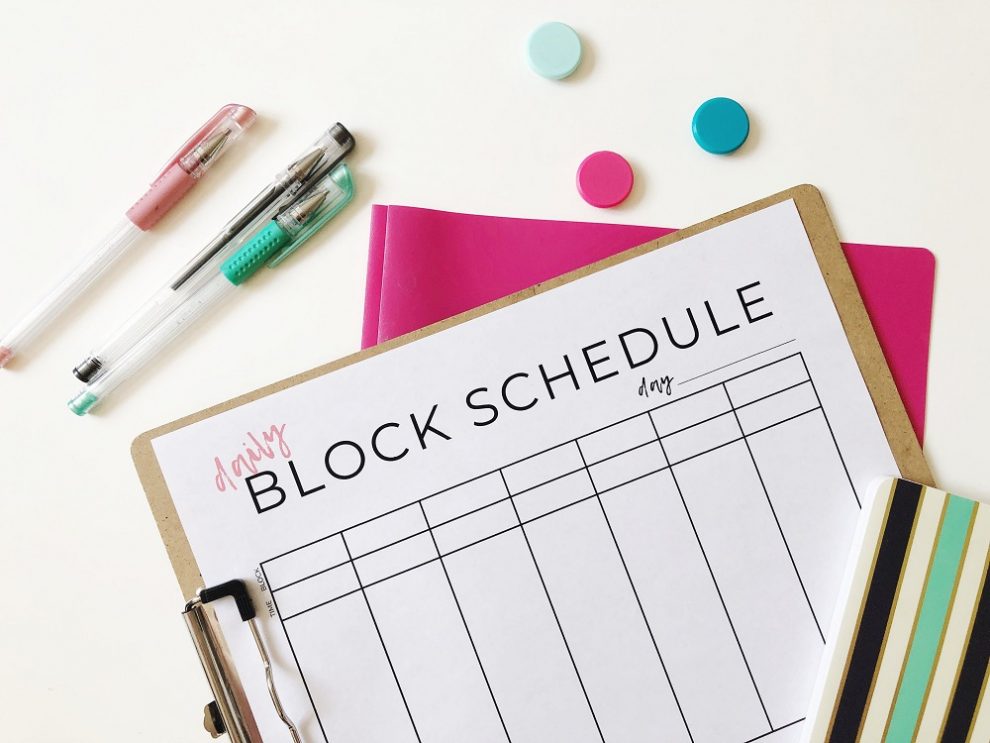Abby Meron: The issue of whether block scheduling should be used in school districts is one that is frequently discussed. Many surveys and google forms have been sent out to get students’ opinions on the issue. In our own district, block scheduling was implemented two and a half years ago, but the real question is whether we should maintain it. Through my overall positive experiences with this more flexible schedule, I believe that it should continue to be utilized. Benefits such as variation in schedules and lengthier periods, make block scheduling popular among the students and teachers, proving it to be a worthwhile pursuit.
Sometimes the monotony of the school day can make it very difficult for students to engage and participate in classes. Having such a routine schedule can create a sense of boredom for students throughout the school day. According to students Ella Mensch and Sophia Morlino, the variation in classes is beneficial and helps them focus more in class. Switching up the order of classes and limiting the number of periods in a day gives students a much-needed mental break. Imagine this, your hardest class is scheduled first thing in the morning every day, leaving you tired, feeling a sense of torment for that first class of the day. With block scheduling, that class does not need to be first every day and that student might be able to perform better due to that unnecessary stress being lifted.
Another upside noted by teachers is the extension of the period. Instead of having 40-minute classes and 8 periods in a day, there are only 6 periods and each class is 50 minutes long. These extra minutes can help teachers teach what they want without worrying about running out of time. They are able to go into more detail about the subjects they love, create more projects and explain concepts more thoroughly. This time can also help when it comes to teachers being able to work closely with each student and address their individual needs. When asked about her opinion on this method, Blind Brook teacher Mrs. Cerasoli stated that she likes the length of the period. On top of this teachers will have more time to plan their classes and work on how they are going to develop their curriculum.
Although more time in class might seem daunting for students it allows them to take fewer classes and have less work assigned to them each day. Along with this, the dropping of certain periods depending on the letter day has also proven to have its benefits. If a student has a test or a lot of homework one night, if they do not have that class the next day they have the opportunity to manage their time more effectively. For example, that student could focus on studying for that test, and then the next night they could finish their homework for the class that was dropped. Having this flexibility can be a great stress reliever and can help those students perform to their fullest potential.
School has proven to be a stressful environment for students and if there is a way to decrease the level of stress we should seize the opportunity. With many benefits, block scheduling provides a better and more efficient way to learn. Although at first, this change to block scheduling can be hard to adjust to, it is worth it in the long run.
Emily Tian: Block Scheduling is a widely known approach used by schools all across the country including our district of Blind Brook. This idea was first brought up by our district in September 2015 and was implemented for the 2019 school year. The Alternate Scheduling Committee at Blind Brook spent a full year on researching and visiting schools that employed an alternative schedule. They hoped to propose a different scheduling model for both the middle and high schools. After deliberating between different ideas, the committee settled on the block scheduling method which rotated different class periods while also dropping two classes per day. Although this has many advantages for the school, it also contains several downsides for its students.
First off, the lack of continuity between each class leads many students to forget information that they had previously learned. Currently, each one-credit class meets six out of the eight-day cycle while elective courses meet even less with only three out of the eight-day cycle. Several teachers have stated their concerns regarding this issue. Many worry that some students would not be able to keep up with their demanding school work if it is not continuously reinforced. A student’s main way of active learning comes from interacting with their teachers every day, however with that taken away, it can be much harder for them to focus and retain content. Although more time is given to teachers, it is actually being used for review work, instead of teaching new material.
Another issue commonly brought up with this schedule is the duration of the class times. Although the long periods may seem beneficial or meaningful to some, they are actually hurting students more. According to a recent study conducted by Brain Balar, the average attention span of a teenager ranges from 28-42 minutes. With block scheduling, the periods are elongated to 53 minutes per class. There is a concern that students have trouble paying attention and absorbing the content for these long classes, resulting in this extra class time being wasted. Some students at Blind Brook High School even describe the schedule as “monotonous” and “dull”. At first glance the schedule may seem more varied or diverse than the previous schedule, however, it is no different than before. The long class periods have caused the number of classes to decrease due to the school day time limit. Because of this, many students tend to sit in their seats for hours on end without any movement. They become bored, tired, and uncomfortable throughout the school day leading to yet again, poor academic performance.
The block scheduling technique results in classes that are very fast-paced, since students meet less often to learn a certain subject or topic. Because of this, many students feel overwhelmed or stressed to keep up with the newly-paced curriculum. This creates a poor and low-spirited environment for many students and staff members. Without the care and attention that they need, students will perform poorly in their school work. In addition, some research even shows that students who used block scheduling have scored lower in science, biology, physics, and chemistry. Whereas, traditional scheduling allows teachers to meet students every day and help them retain information and get the help that they need. These daily communications and interactions are vital in keeping a student energized and focused on their classroom activities.
Overall, it is clear that some refinements need to be made to the blocked schedule to create an ideal environment for students and teachers. However, as the Blind Brook School District keeps progressing and advancing, changes will hopefully be made to the high school’ schedule, with it adapting and evolving to the students’ and teachers’ needs.







